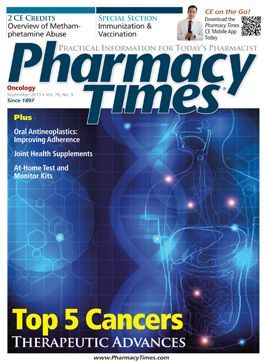Boehringer Ingelheim Pharmaceuticals' Gilotrif
Gilotrif (afatinib) is FDA approved for treating certain non-small cell lung cancers.
Gilotrif (afatinib) is FDA approved for treating certain non-small cell lung cancers.
Gilotrif (afatinib) tablets were approved by the FDA on July 15, 2013, as a first-line oral treatment for non—small cell lung cancers (NSCLCs) with epidermal growth factor receptor (EGFR) mutations.1 Using an FDA-approved test kit, clinicians can make an informed decision on whether to initiate Gilotrif based on EGFR mutations in cancer cells. Although the effectiveness of Gilotrif has been validated in patients with NSCLC with exon 19 deletions and exon 21 (L858R) substitution mutations, efficacy and safety have not been proved with other types of EGFR mutations.2
Pharmacology and Pharmacokinetics
Gilotrif, a tyrosine kinase inhibitor, reduces ErbB signaling by binding to the kinase domains of EGFR, HER2, and HER4. ErbB receptors are involved in the growth and proliferation of cancer cells.2
Maximum concentrations of Gilotrif occur 2 to 5 hours after administration. With an elimination half-life of 37 hours, steady-state plasma levels are reached within 8 days. In pharmacokinetic studies, high-fat meals and p-glycoprotein (p-gp) inhibitors increased peak concentrations of Gilotrif and total exposure to it. Gilotrif is minimally metabolized by liver enzymes, with 88% of each dose recovered unchanged, primarily in feces.2
Patients with mild to moderate renal impairment experienced higher trough concentrations of Gilotrif than patients with normal renal function. Hepatic impairment did not affect exposure. No dose adjustment is required in hepatic or renal impairment, but patients with severe renal impairment (creatinine clearance <30 mL/min) and patients with Child-Pugh class C hepatic dysfunction have not received Gilotrif in clinical studies.2
Dosage and Administration
A single daily oral dose of Gilotrif should be taken on an empty stomach ≥1 hour before or ≥2 hours after a meal, preferably at the same time each day. If a patient misses the usual administration time, the missed dose may be taken at a later time, but only if the patient separates daily doses by at least 12 hours. The usual daily dose of Gilotrif is 40 mg, although dose reductions may be necessary when restarting therapy after adverse events or to manage drug interactions.2
Clinical Trials
Patients with metastatic, nonsquamous NSCLC received Gilotrif (230 patients) or pemetrexed/cisplatin (115 patients). The median patient age was 61 years. More than half (50.4%) of patients receiving Gilotrif experienced complete or partial response versus 19.1% of patients using pemetrexed/cisplatin.2
Patients taking Gilotrif experienced a median progression-free survival of 11.1 months versus 6.9 months for patients taking pemetrexed/cisplatin (P <.001). In terms of overall survival, patients using Gilotrif who had exon 19 deletions survived for a median of 31.6 months versus 21.1 months in patients with exon 19 deletions receiving pemetrexed/cisplatin (P <.001).2
Warnings and Precautions
P-gp inhibitors like ritonavir, cyclosporine, ketoconazole, itraconazole, erythromycin, verapamil, tacrolimus, and amiodarone may increase exposure to Gilotrif. Likewise, p-gp inducers such as rifampin, carbamazepine, phenytoin, phenobarbital, and St John’s Wort may reduce exposure to Gilotrif. Concomitant use of a p-gp inhibitor requires a 10-mg Gilotrif dose reduction. If the p-gp inhibitor is discontinued, the usual dose of Gilotrif may be restored after 2 to 3 days without the p-gp inhibitor.2
Gilotrif is a pregnancy category D medication. Animal studies in rats and rabbits show an increased risk of fetal death, reduced fetal weight, and skeletal, vascular, and dermal abnormalities.2
Diarrhea, cutaneous reactions, or renal dysfunction may require temporary discontinuation, depending on severity. Other adverse reactions such as severe hepatic impairment, interstitial lung disease, symptomatic left ventricular dysfunction, or life-threatening skin lesions may require permanent discontinuation of treatment.2
Diarrhea occurred in 96% of patients, with 6.1% of patients experiencing renal impairment due to severe diarrhea. Cutaneous reactions occurred in 90% of patients, but a minority (0.15%) of patients had severe bullous or exfoliating lesions. Of the 14% of patients who discontinued Gilotrif due to adverse reactions, the most common reasons for discontinuation were diarrhea, interstitial lung disease, and paronychia. For a complete discussion of possible adverse events, please consult the product package insert.2
Michael R. Page earned his PharmD from the Ernest Mario School of Pharmacy at Rutgers University. He has worked as a community pharmacist at CVS Pharmacy and is currently clinical editor in clinical and scientific affairs at Pharmacy Times.
References
- Boehringer Ingelheim [press release]. US FDA approves Gilotrif (afatinib) as first-line treatment for lung cancer patients with EGFR mutations. www.boehringer-ingelheim.com/news/news_releases/press_releases/2013/15_july_2013_oncology.html. Accessed August 2013.
- Gilotrif (afatinib) [package insert]. Ridgefield, CT: Boehringer Ingelheim Pharmaceuticals, Inc; 2013.

